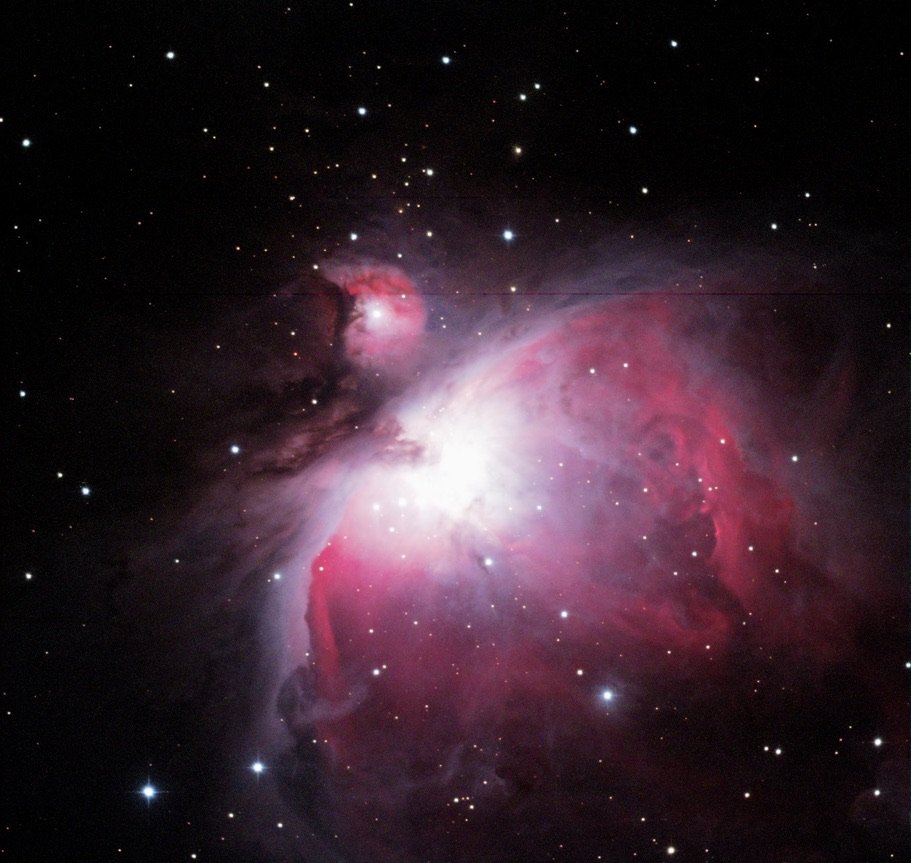
Andromeda Galaxy
At more than 2.5 million light years away from earth, the Andromeda Galaxy is our nearest galactic neighbor. It’s the furthest object in the night sky that you can see with the naked eye, and on a really clear day, it’s one of the easier deep space objects to photograph. (Taken with Camera)

Orion Nebula
At roughly 1,400 light years from Earth, the Orion Nebula is truly one of the great wonders of the night sky. The Nebula is located just below the belt of the iconic Orion Constellation. Additionally, the Orion Nebula is one of the most luminous nebulae in the night sky, and on a perfectly clear night, it is visible with the naked eye. (Taken with Telescope)

Tarantula Nebula
The Tarantula Nebula is located outside the Milky Way at roughly 160,000 light years from Earth. One of the truly gargantuan nebulae in the night sky, the Tarantula Nebula has a radius of about 1,000 lightyears. Additionally, the Tarantula Nebula is one of the most luminous non-stellar celestial bodies. (Taken with Telescope)

Silver Coin Galaxy
The Silver Coin Galaxy, also known as the Sculptor Galaxy, is roughly 10 million light years away and boasts a diameter of roughly 90,000 light years. The Silver Coin Galaxy is a member of the Sculptor Group of galaxies, which is one of the closest clusters to our own Local Group. This Galaxy is classified as a starburst galaxy, which means it has an extremely high rate of star production. While the Milky Way produces roughly 3 stars a year, the Silver Coin Galaxy could produce dozens of times more than the Milky Way. (Taken with Telescope)

The Milky Way Band
One of the many wonders of the Universe, the Milky Way band is visible on clear nights all around the world. Galileo once claimed that within the band there were “innumerable stars grouped together in clusters too small and distant to be resolved into individual stars by the naked eye”, and I think the same every time I stare into the Milky Way’s vast expanse. (Taken on camera)

47 Tucanae
47 Tucanae is one of the largest globular clusters in our night sky, comprising millions of stars. At around 13,000 light years from Earth, this cluster can appear as large as a full moon on a very clear night. (Taken with Telescope)

Waning Gibbous Moon
The Moon is the largest satellite in relation to its orbitational partner (Earth) in our solar system, and is Earth’s only natural satellite. It is the only extraterrestrial body that humans have ever set foot on. The Moon helps regulate many things on Earth from our orbit to the tides, and has inspired millennia of mythology. (Taken with camera)

A Meteorite
Zipping through the night sky at tens of thousands of miles per hour, meteorites typically are most present in our night sky in August. Seeing a meteor shower on a warm Summer night is one thing, but capturing this phenomenon on camera is unlike anything else in the world. (Taken with Camera)

The Big Dipper
The Big Dipper is one of the most recognizable constellations in the night sky. Visible every night of the year in the Northern Hemisphere, the Big Dipper alone is a large constellation, but is in fact part of the larger Ursa Major. (Taken with Camera)

Dumbbell Nebula
At the very close range of 1,300 light years, the Dumbbell Nebula was named after its unique shape. The Dumbbell Nebula was created by the death of a star with similar dimensions to that of our own Sun, and shows what the future of the Sun might be. (Taken with telescope)

Horsehead Nebula
Resting within the Constellation Orion, the Horsehead Nebula is notoriously difficult to photograph due to its close proximity to several very luminous stars. The Horsehead Nebula is among the more recognizable nebula, and is one of my personal favorites. (Taken with telescope)

Silhouettes
One of the greatest parts of being an astrophotographer is being able to share my experiences with others. When I invited some of my friends from the Philippines to see the stars in New Hampshire, I couldn’t help myself from taking this photo of them gazing, mesmerized by the starry night. (Taken with camera)

The Pleiades Star Cluster
The Pleiades are one of the brightest open star clusters in the night sky. Easily visible with the naked eye, the Pleiades are most recognizable for their flagship seven stars, which many astronomers know as The Seven Sisters. (Taken with camera)